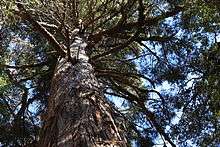Athrotaxis laxifolia
Athrotaxis laxifolia is a species of Athrotaxis, endemic to Tasmania in Australia, where it grows at 1,000–1,200 m altitude.[2][1]
| Athrotaxis laxifolia | |
|---|---|
 | |
| Scientific classification | |
| Kingdom: | Plantae |
| Clade: | Tracheophytes |
| Division: | Pinophyta |
| Class: | Pinopsida |
| Order: | Pinales |
| Family: | Cupressaceae |
| Genus: | Athrotaxis |
| Species: | A. laxifolia |
| Binomial name | |
| Athrotaxis laxifolia | |
It is an evergreen coniferous tree growing to 10–20 m tall, with a trunk up to 1 m diameter. The leaves are scale-like, 4–12 mm long and 2–3 mm broad, arranged spirally on the shoots. The seed cones are oblong-globose, 15–26 mm long and 14–20 mm diameter, with 14–18 spirally-arranged scales; they are mature about six months after pollination. The pollen cones are 3–5 mm long.[2]
Its status in the wild is little-known; it is the rarest of the three species of Athrotaxis. It is in many respects intermediate between Athrotaxis cupressoides and Athrotaxis selaginoides, and it is strongly suspected of being a natural hybrid between these two; however, genetic evidence for this is inconclusive.[2]
Away from its native range, it is occasionally cultivated as an ornamental tree in northwestern Europe. Despite being the rarest of the three in the wild, it is the most frequently planted Athrotaxis in cultivation, though still only seen in major collections; trees in Ireland have reached 20 m tall.[3][4]
References
- Conifer Specialist Group 2000. Athrotaxis laxifolia
- Farjon, A. (2005). Monograph of Cupressaceae and Sciadopitys. Royal Botanic Gardens, Kew. ISBN 1-84246-068-4
- Mitchell, A. F. (1974). A Field Guide to the Trees of Britain and Northern Europe. Collins ISBN 0-00-212035-6
- Tree Register of the British Isles
